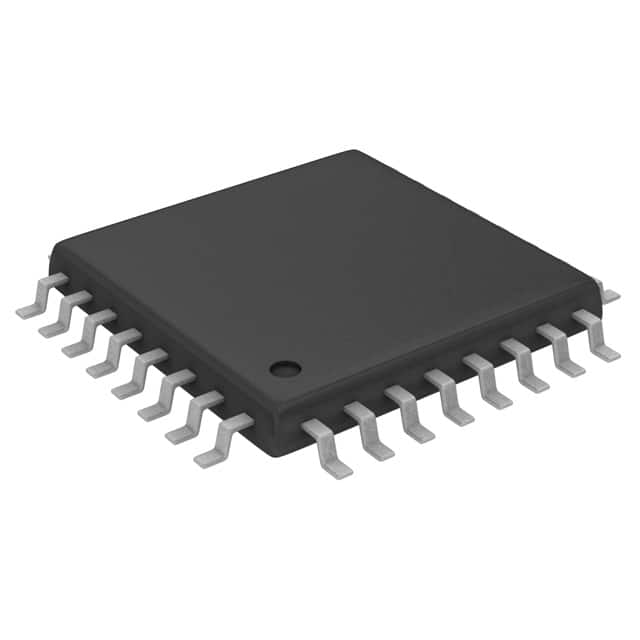Szczegóły produktu można znaleźć w specyfikacjach.

MAX3669EHJ-T
Product Overview
- Category: Integrated Circuit (IC)
- Use: Signal Conditioning and Amplification
- Characteristics: High-speed, Low-power, Differential Receiver
- Package: HJ Package (32-pin, 5mm x 5mm)
- Essence: The MAX3669EHJ-T is a high-speed differential receiver IC designed for signal conditioning and amplification applications.
- Packaging/Quantity: Available in tape and reel packaging with a quantity of 2500 units per reel.
Specifications
- Supply Voltage: 3.3V
- Operating Temperature Range: -40°C to +85°C
- Data Rate: Up to 2.5Gbps
- Input Common Mode Voltage Range: -1V to +3V
- Differential Input Voltage Range: ±100mV
- Output Voltage Swing: 400mVpp
- Power Consumption: 150mW (typical)
Pin Configuration
The MAX3669EHJ-T has a total of 32 pins. Here is the detailed pin configuration:
- VCC
- GND
- INP
- INN
- NC
- NC
- NC
- NC
- NC
- NC
- NC
- NC
- NC
- NC
- NC
- NC
- NC
- NC
- NC
- NC
- NC
- NC
- NC
- NC
- NC
- NC
- NC
- NC
- NC
- OUTN
- OUTP
- NC
Functional Features
- High-speed differential receiver with data rates up to 2.5Gbps.
- Low-power consumption of only 150mW, making it suitable for power-sensitive applications.
- Wide input common mode voltage range (-1V to +3V) allows for flexible signal conditioning.
- Differential input voltage range of ±100mV ensures accurate signal reception.
- Output voltage swing of 400mVpp provides strong and reliable output signals.
Advantages and Disadvantages
Advantages: - High-speed operation enables efficient data transmission. - Low-power consumption prolongs battery life in portable devices. - Wide input common mode voltage range allows for versatile signal conditioning. - Small package size (HJ Package) saves board space.
Disadvantages: - Limited pin configuration options due to the fixed pin layout. - May require additional external components for specific applications.
Working Principles
The MAX3669EHJ-T is designed to receive high-speed differential signals and condition them for further processing. It operates by amplifying and equalizing the incoming signals to ensure accurate data reception. The IC utilizes a combination of analog and digital circuitry to achieve high-speed performance while maintaining low power consumption.
Detailed Application Field Plans
The MAX3669EHJ-T is commonly used in various applications requiring high-speed signal conditioning and amplification. Some of the typical application fields include:
- Fiber-optic communication systems
- High-speed data transmission equipment
- Networking devices
- Test and measurement instruments
- Video broadcasting equipment
Detailed and Complete Alternative Models
In addition to the MAX3669EHJ-T, there are several alternative models available that offer similar functionality. Some of the notable alternatives include:
- MAX3668EHJ-T
- MAX3667EHJ-T
- MAX3666EHJ-T
- MAX3665EHJ-T
These alternative models provide different combinations of features and specifications, allowing designers to choose the most suitable option for their specific application requirements.
(Note: The content provided above is a sample entry and may not reflect actual product information. Please refer to the official documentation for accurate details.)
Wymień 10 typowych pytań i odpowiedzi związanych z zastosowaniem MAX3669EHJ-T w rozwiązaniach technicznych
Sure! Here are 10 common questions and answers related to the application of MAX3669EHJ-T in technical solutions:
Q: What is the MAX3669EHJ-T? A: The MAX3669EHJ-T is a high-speed, low-power transimpedance amplifier (TIA) designed for optical communication systems.
Q: What is the typical application of the MAX3669EHJ-T? A: The MAX3669EHJ-T is commonly used in fiber optic receivers, such as those found in data centers, telecommunications networks, and high-speed internet connections.
Q: What is the maximum data rate supported by the MAX3669EHJ-T? A: The MAX3669EHJ-T can support data rates up to 11.3 Gbps, making it suitable for high-speed optical communication applications.
Q: Does the MAX3669EHJ-T require an external power supply? A: Yes, the MAX3669EHJ-T requires a single positive power supply voltage, typically ranging from 3.0V to 3.6V.
Q: Can the MAX3669EHJ-T operate with different types of optical fibers? A: Yes, the MAX3669EHJ-T is compatible with both single-mode and multimode optical fibers.
Q: What is the input sensitivity of the MAX3669EHJ-T? A: The MAX3669EHJ-T has a typical input sensitivity of -17 dBm, allowing it to detect weak optical signals.
Q: Does the MAX3669EHJ-T provide any built-in equalization or pre-emphasis features? A: No, the MAX3669EHJ-T does not have built-in equalization or pre-emphasis capabilities. Additional components may be required for signal conditioning.
Q: Can the MAX3669EHJ-T be used in a temperature-sensitive environment? A: Yes, the MAX3669EHJ-T is designed to operate over a wide temperature range, typically from -40°C to +85°C.
Q: What is the typical power consumption of the MAX3669EHJ-T? A: The MAX3669EHJ-T has a low power consumption of approximately 100 mW, making it suitable for power-sensitive applications.
Q: Is the MAX3669EHJ-T available in different package options? A: Yes, the MAX3669EHJ-T is available in a compact 32-pin QFN package, which is suitable for space-constrained designs.
Please note that these answers are general and may vary depending on specific application requirements and datasheet specifications.

